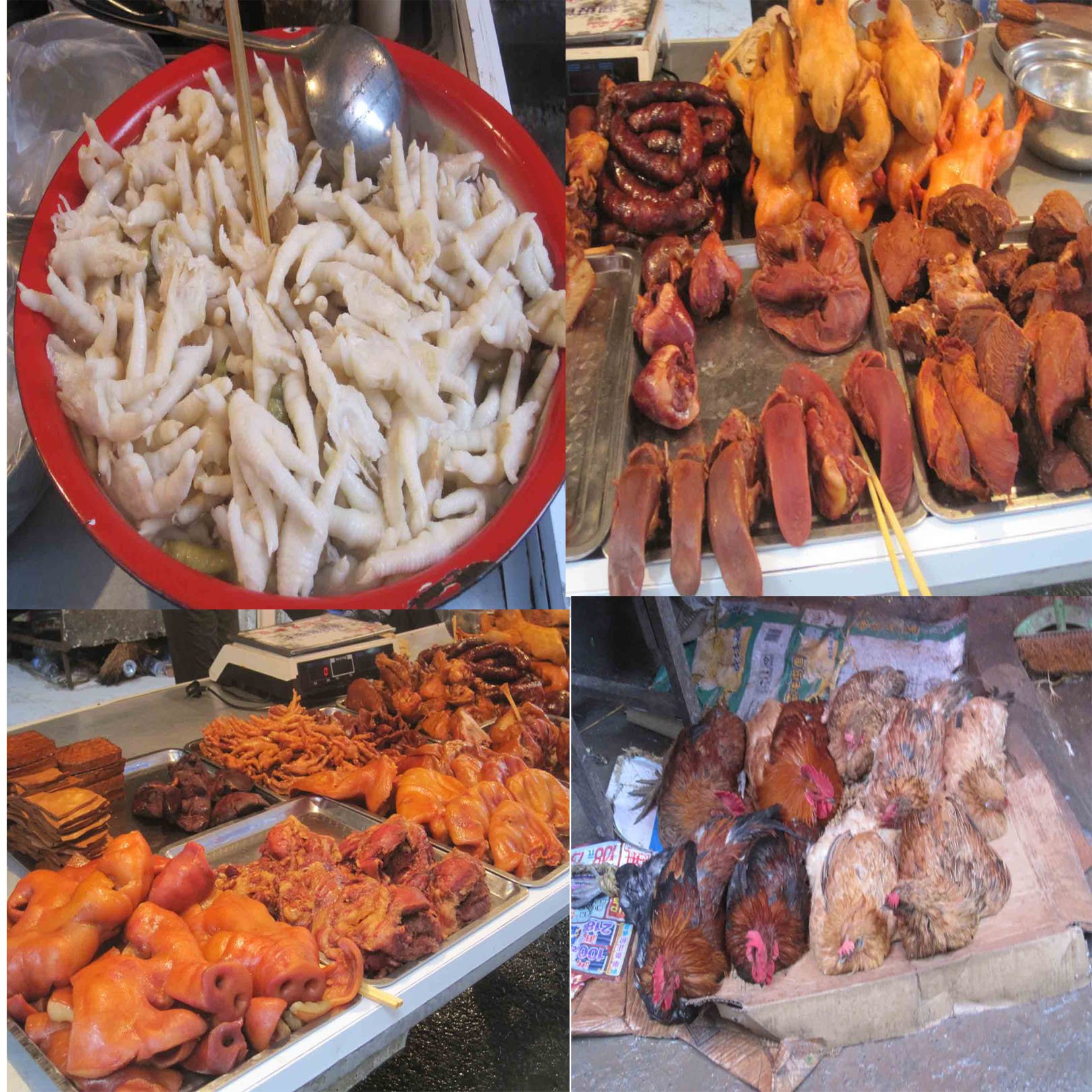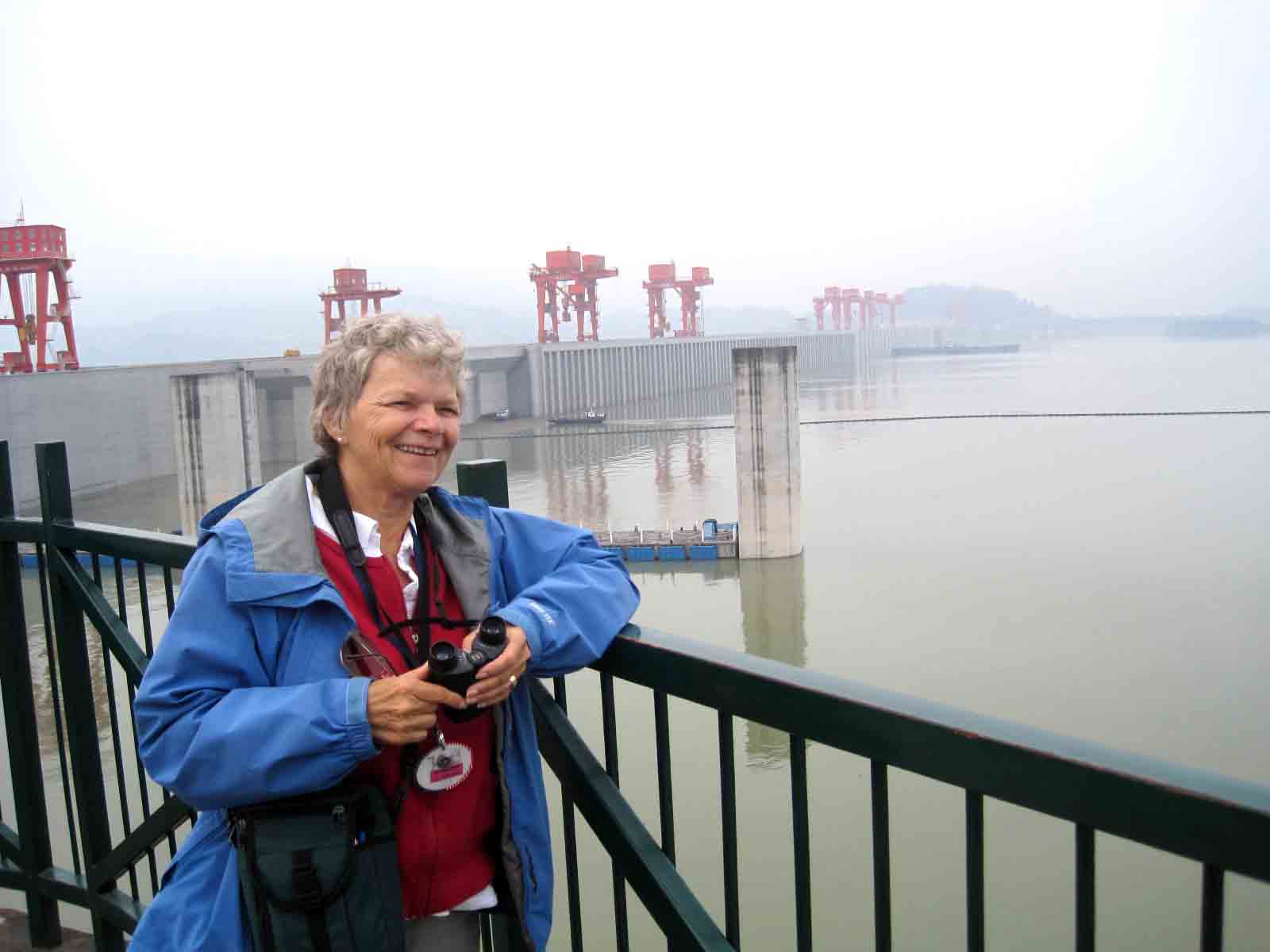Our Our 2010 China Tour Page 7
The photos on this page are part of our Yangtze River Cruise. We left from Chongqing and cruised about 400 miles to below The Three Gorges Dam in Yichang

Chongquing (aka Chungking) is a major city in southwestern mainland China. Administratively, it is one of the People's Republic of China's four direct-controlled municipalities (the other three are Beijing, Shanghai and Tianjin). In 2007, the municipality of Chongqing had a population of 31.4 million.It is possibly the world's largest municipality by area and population. It serves as the economic center of the Upstream Yangtze area, a modern manufacturing centre and a transportation hub for Southwest China. This is where we boarded our cruise ship.

Chongquing (for me) is also known for the nice supermarket that we went to before boarding the ship. The supermarket was huge. It had 3 floors connected by moving ramps for your shopping cart. I especially like the fruit section because it had pomelos and dragon fruit. I'm holding a dragon fruit which comes from a cactus and is grown world-wide. I've never seen on in the US. The edible flesh inside can range from white to blue to red. Very tasty! I had some for breakfast almost every day. (Its color also matches my cap Woo-Hoo.)


This was our home for 4 days on the Yangtze. It is one of many, many cruise ships we saw on the river. It is about 300 feet long and 54 feet wide. It weighs 5000 tons (compared to ocean cruise ships weighing 100 tons or more). There are 5 decks, 100 cabins and can carry 200+ passengers. It was a clean, modern ship and our "state room" which had a balcony was quite comfortable.

On the morning of day 16 we went ashore at Fengdu (not to be confused with Chengdu). Fengdu is where the devil lives, according to Chinese legend. They say that good spirits go to heaven and the evil ones goes to Fengdu. It certantly looked evil on that rainy morning!

Instead of going to the touristy parts of Fengdu, we went to the old town market place. This is where the locals shop. These 4 pictures are some of the foods we saw: Chicken feet for frying, tongues, hearts, pig faces, and live chickens that can be killed and plucked "while you wait". I've included them because you'll probably never see them in your local supermarket and this is what all we think Chinese people eat (they do).

Here are a few folks we saw in the market place: A little boy talking on a cell phone and a grandmother with her little grand child. The Chinese people are truly beautiful - especially the kids!
We visited an ex-farm woman whose home was destroyed by the rising Yangtze waters above the Three Gorges Dam. They had 3 choices on relocation: Build a new home, move to higher ground and build a new home and farm, or move in with relatives. They chose the fist option: Build a new home. They now live in a clean comfortable 2 story house with a store below and an apartment above. She said it was the best thing they had done. No more back breaking farm work and they have a store to provide income. Although they do miss the village life along the river. We all sat in her living room listening to her story as translated by Joan. This picture shows some of our tour group. More pictures of them later.
We returned to the ship, had lunch, and continued down river. We passed a lot of small towns and villages and a lot of new bridges. The river was brown with Tibetan Plateau silt, but there was no trash in the water. You can get an idea of the scale of things by noting the cruise ship and the bridge.
We left the Victoria Queen and boarded a small passenger ferry at the mouth of the Daning River, one of the many Yangtze tributaries. This small ship held the 200+/- cruise ship passengers and we had a narrated tour of the river.
Along the Daning River, we passed through an area called the Lesser Gorges. This wa a spectacular place: Narrow river and steep walled gorges. To get an idea of the size of the "lesser" gorges, take a look at the tiny rear end of the passenger ferry going around the bend in the upper picture. Note the lighter colored rocks along both sides of the gorge. a couple of years ago, the Three Gorges Dam was shut and the waters were able to back up and rise to 175 meters (575 feet) above sea level. After 3 months, the water level was dropped 30 feet and the rocks had been washed to a lighter color.
We left the passenger ferry and boarded a small sampan where the Daning River became narrowed, one of the many Yangtze tributaries. The boatman was a singer as well as a poler. He had on an old rain hat and cape and a new PFD. Nice touch!
Here are two more views along the Daning River: The Big Budda Mountain in the top picture and the Hanging Coffins in the bottom. An ancient ethnic group called The Bo people lived here and in other parts of China as far back as 700 BC. The hanging coffin was their most widespread form of burial in ancient southwest China. However, the practice ended with the mysterious disappearance of the Bo People. You can just barely make out a couple of shallow caves in the cliff face. With binoculars, you can see long wooden objects in the caves. Those are the coffins.
Back on the passenger ferry heading back to the Yangtze we saw some of the construction for a new hanging walkway. This is supposed to be something the tourist will use a part of their river adventure. Get off at one end and walk to the other end - for about 2 miles.
Back on our cruise ship and continuing down the river we went through the Wu Gorge and passed the Goddess Peak. The Goddess is that spire of rock in the "U" shaped notch on the mountain. Legend has it that the early boatmen thought she brought good luck. She is about 50 feet tall. The Wu gorge is the first of the three gorges that make up the name of the dam further down stream. The other two gorges are the Qutang and the Yiling.
We had a couple of nice shows aboard the cruise ship in the evenings. One was put on by members of the ships company and one was put on by a group of the ship's passengers. Can you tell which is which? Actually, the top picture is of our waitresses doing their evening shift and the bottom picture is of our tour group singing the Chinese song "Jasmine Flower" IN CHINESE!. Joan talked us into it and she rehearsed us several times. We sang to the rest of the passengers. Mary Ann is in front giggling.
Here is a typical relocated village on the Yangtze. There were 1.3 million people displaced and many of them built homes above the high water mark. Note the old cruise ships undergoing repairs and renovation or just plain rusting away. Also note the rugged mountains behind the village!
This is the last of the 3 gorges: The Yiling Gorge. Beyond it is the Three Gorges Reservoir. Note another relocated village on the right.
We went through the 5 downward locks at the dam during the evening of our "concert" and came ashore in the village of Yiling. A tour bus brought us up to some dam viewpoints. This is the lake behind the dam. The cranes are to install and service the 26 700 megawatt generators. The generators can produce an annual generation of 80,000 gigawatts. The length of the dam is 7,661 feet, its height is 607 feet and its thickness at the base is 377 feet. TMI?
This is a model of the Dam. You can see the dam, spillway, the 5 up locks, the 5 down locks and between the locks and the dam is where the ship elevator will be. The dam cost $26 Billion to build (Our "Big Dig cost about $18 Billion.) It was completed in 2008 and revenues from electricity sales have so far paid off more than 1/3 of the construction costs. It is truly an impressive achievement
One final picture before we head to Hong Kong: This little kid was having a take-out noodle lunch. He looked real cute so I snapped his picture. When I did, an old woman started chasing me shouting "Gimmee dollar, Gimmee dollar" I didn't and got a nice picture "Cheapee, Cheapee". (I also liked getting the guy frying little fishes.) 
















That's it for the Yangtze River, The Three Gorges area and The Three Gorges Dam. It was an interesting trip!
Go to Home
Go to P.2
Go to P.3
Go to P.4
Go to P.5
Go to P.6
Go to P.8
Go to P.9